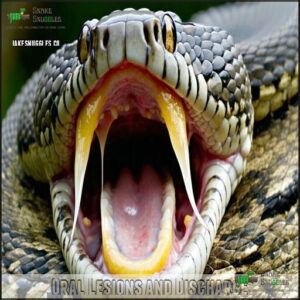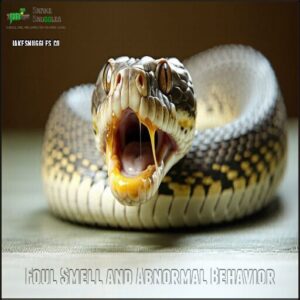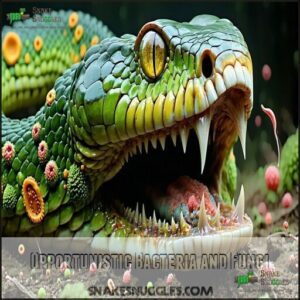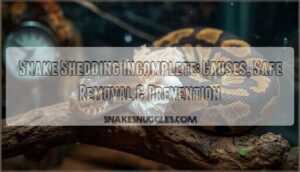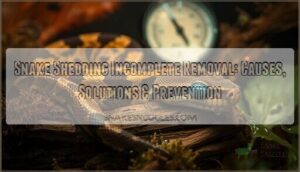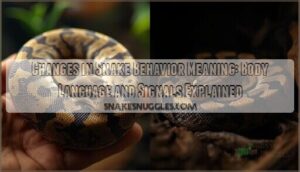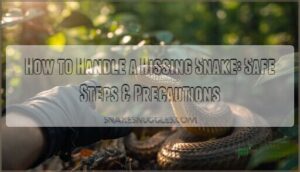This site is supported by our readers. We may earn a commission, at no cost to you, if you purchase through links.

A balanced diet and fresh water are essential too, as malnutrition weakens their immune system. Inspect their mouth regularly for any signs of redness, swelling, or discharge because catching it early makes a world of difference.
Avoid overcrowding and injuries from rough surfaces or prey. Think of it like this: happy, healthy snakes in a clean, stress-free environment rarely get sick.
Curious about spotting subtle signs? Let’s explore further, considering the importance of early detection.
Table Of Contents
- Key Takeaways
- Preventing Mouth Rot
- Recognizing Early Signs
- Causes and Contributing Factors
- Effective Treatment Options
- Managing Environmental Stress
- Frequently Asked Questions (FAQs)
- How do you stop mouth rot?
- How to stop scale rot in snakes?
- What medication is used for reptile mouth rot?
- Can mouth rot spread to other reptiles?
- Does mouth rot affect breeding in snakes?
- How does stress affect recovery from mouth rot?
- Are certain snake species more prone to mouth rot?
- How long does it take snakes to recover?
- Conclusion
Key Takeaways
- Keep the enclosure clean and maintain proper temperature and humidity levels to prevent bacterial growth and stress in your snake.
- Inspect your snake’s mouth regularly for early signs like redness, swelling, or discharge to catch mouth rot before it worsens.
- Feed a balanced diet and provide fresh water to boost your snake’s immune system and prevent nutritional deficiencies.
- Reduce stress by avoiding overhandling, providing hiding spots, and using safe handling and feeding practices.
Preventing Mouth Rot
You can prevent mouth rot in your snake by maintaining proper cage temperatures, guaranteeing good nutrition, and promptly addressing any mouth injuries or signs of stress.
Regular monitoring of your pet’s mouth during handling sessions won’t just keep them healthy—it’ll save you from costly vet bills and guarantee your scaly friend continues to flick their tongue happily for years to come, which is crucial for their overall health and well-being.
Routine mouth checks ensure a healthy, happy snake, saving you from unexpected vet bills and keeping their unique charm alive.
Maintaining Ideal Environment
A well-maintained enclosure is your first defense against snake mouth rot. Creating ideal conditions prevents stress and bacterial growth that lead to infections.
- Maintain proper temperature gradients (75-90°F depending on species) with warm and cool zones
- Control humidity levels (40-60% for most species, higher for tropical species)
- Use appropriate substrate choices that don’t harbor bacteria or cause injuries
Ideal health depends on proper temperature control. Clean the enclosure weekly, removing waste promptly to prevent bacterial buildup, which is crucial for preventing stress and ensuring the overall well-being of the snakes.
Proper Nutrition and Hydration
Many snakes develop mouth rot due to poor nutrition weakening their immune system. Your pet’s diet directly impacts its ability to fight infections.
Ensuring your snake receives the proper snake vitamins and prey is vital for their health.
| Nutritional Factor | Prevention Strategy | Impact on Mouth Rot |
|---|---|---|
| Essential Vitamins | Prey Gutloading | Strengthens immune response |
| Hydration Methods | Water bowl/misting | Prevents oral tissue damage |
| Supplement Schedules | Weekly calcium/D3 | Supports tissue healing |
Don’t overlook gut health—properly fed prey and consistent hydration dramatically reduce nutritional deficiencies linked to stomatitis.
Reducing Stress and Trauma
Stress and trauma are silent killers for your snake’s immune system.
You’ll need to provide adequate hiding places throughout the enclosure to create security. Safe handling practices, proper enclosure size, and social isolation from other reptiles prevent unnecessary stress.
Always offer pre-killed prey to avoid bite injuries that can lead to snake mouth rot. Remember, good snake husbandry means recognizing when your pet needs space—prevention is always easier than treatment.
Maintaining proper humidity helps prevent bacterial and fungal growth, which is crucial for a healthy environment, emphasizing the importance of proper enclosure size and prevention.
Recognizing Early Signs
You’ll save your snake‘s life by spotting mouth rot early through changes like decreased appetite, redness around the mouth, or unusual discharge.
Spotting early signs, like appetite loss or redness, can mean the difference between a quick fix and a life-threatening infection.
Catching these warning signs before they progress can mean the difference between a simple treatment and a serious, potentially fatal infection.
Loss of Appetite and Weight
Often, the first warning sign of mouth rot is your snake’s sudden refusal to eat.
You’ll notice your pet skipping meals due to pain while attempting to strike or swallow prey.
Weight loss follows quickly as digestive issues and reduced nutritional absorption occur.
Monitor your snake’s metabolic rate by tracking regular feeding patterns and prey preference.
Hydration impact is significant too—dehydration compounds these symptoms, making weight loss more severe.
Lethargy, another sign, can indicate underlying health issues, which may suggest underlying health issues and lead to weight loss and dehydration.
Oral Lesions and Discharge
While your snake’s appetite loss might be concerning, physical changes in the mouth are unmistakable warning signs.
Oral lesions and discharge require immediate attention.
Watch for these telltale indicators:
- White or yellowish plaques with cheesy discharge
- Reddened gum tissue with visible bleeding
- Thick mucus or pus around mouth edges
- Areas of tissue necrosis (dead tissue appearing gray or black)
Excess saliva often accompanies these symptoms, creating a wet appearance around your snake’s mouth, which can be a sign of oral lesions and may lead to tissue necrosis.
Foul Smell and Abnormal Behavior
Your snake’s breath doesn’t lie – a foul smell from the mouth often signals advanced stages of mouth rot.
You’ll notice behavioral changes like increased aggression or unusual lethargy, clear pain indicators when your pet refuses food.
| Behavioral Sign | What It Means | Severity Level |
|---|---|---|
| Lethargy | Systemic Effects | Moderate-High |
| Head-rubbing | Pain Response | Moderate |
| Food Refusal | Advanced Infection | High |
Don’t ignore these warning signs – they’re your reptile’s cry for help, indicating advanced stages of illness, and potentially systemic effects, which can lead to severe consequences if not addressed promptly.
Causes and Contributing Factors
Your snake’s mouth rot isn’t a random occurrence but results from specific triggers you need to understand.
Opportunistic bacteria and fungi typically exploit weakened immune systems caused by poor husbandry practices, inadequate temperature regulation, nutritional deficiencies, or stress from overcrowding and trauma.
The triggers include poor husbandry practices, inadequate temperature regulation, nutritional deficiencies, or stress from overcrowding and trauma.
Opportunistic Bacteria and Fungi
Your snake’s oral health faces a stealthy enemy: opportunistic microbes that lurk unseen until conditions favor infection.
Bacterial culprits like Pseudomonas aeruginosa and E. coli attack when immune suppression occurs, while Aspergillus and other fungal species exploit weakened defenses.
These microorganisms establish infection pathways that can quickly deteriorate into painful mouth rot.
Be aware that overuse of medications can lead to antibiotic resistance, complicating treatment of bacterial infections.
Contaminated soil, a breeding ground for fungi, can also contribute to these fungal infections.
Poor Husbandry and Hygiene
Consistently poor husbandry practices create perfect breeding grounds for mouth rot in your snake.
Inadequate cage sanitation and infrequent waste removal allow harmful bacteria to flourish in the enclosure. Your choice of substrate matters too—damp or soiled bedding accelerates bacterial growth.
Poor water quality and inappropriate enclosure size further compromise your reptile’s health.
Unsanitary housing conditions directly contribute to oral infections, making proper enclosure cleanliness a non-negotiable aspect of reptile husbandry, and emphasizing the importance of harmful bacteria control.
Weakened Immune System
A snake’s weakened immune system acts as an open invitation for mouth rot pathogens.
Nutritional deficiencies, stress factors, and underlying conditions all compromise your pet’s natural defenses.
Poor husbandry impact, including incorrect temperatures and humidity levels, further suppresses immunity.
Viral complications can overwhelm an already taxed system.
Your snake’s immune system requires proper care—adequate nutrition, minimal handling during vulnerable periods, and appropriate habitat maintenance—to effectively fight off bacterial and fungal invaders, and provide a healthy environment.
Effective Treatment Options
You’ll need to act quickly with proven treatments once you’ve identified mouth rot in your snake.
Proper antibiotic therapy, combined with thorough oral cleaning and supportive care, will give your scaled companion the best chance for a complete recovery.
Antibiotics and Antifungal Medication
When facing snake mouth rot, the right medications can mean all the difference.
Veterinarians typically prescribe antibiotics like enrofloxacin, ceftazidime, or amikacin initially, though options may change based on bacterial culture results.
For fungal infections, medications such as clotrimazole are essential.
You’ll need to follow dosage guidelines carefully, as antibiotic resistance in reptiles is common.
Early-stage cases might respond to topical treatments alongside improved husbandry.
Surgical Intervention and Supportive Care
Surgical intervention becomes necessary when your snake’s mouth rot progresses beyond what medications alone can treat.
A veterinarian will perform debridement techniques under anesthesia protocols to remove infected tissue.
- Post-op care includes daily wound cleaning and antibiotic application
- Fluid therapy prevents dehydration during recovery
- Nutritional support may require force-feeding or liquid diets
Recovery requires patience—your scaly friend needs consistent supportive care while healing from surgery.
Probiotic Therapy and Oral Hygiene
Beyond surgery, maintaining your snake’s oral health requires a two-pronged approach.
Probiotic therapy supports a healthy gut microbiome and immune system, with Lactobacillus-based supplements showing promise in preventing mouth rot.
For oral hygiene, use daily chlorhexidine rinses and reptile-specific soft brushes to remove plaque.
Avoid human oral products, which can be toxic. Many owners find snake probiotic products helpful for gut health.
Regular cleaning with appropriate solutions establishes healthy flora, making preventative care substantially easier than treating full-blown infections.
Managing Environmental Stress
You’ll need to manage your snake’s environmental stress to prevent deadly mouth rot infections that thrive when your pet feels threatened or uncomfortable.
Creating a stable habitat with proper temperature gradients, adequate hiding spots, and regular cleaning will strengthen your snake’s immune system and substantially reduce its vulnerability to bacterial invasions, which is crucial for preventing deadly mouth rot infections.
Influence of Temperature and Humidity
Even the most effective treatments can fail if your snake’s environment isn’t properly maintained.
Proper temperature gradients and humidity levels are the foundation of mouth rot prevention.
Keep the warm side between 88-92°F and the cool side at 75-80°F. Maintain humidity at 50-60% normally, increasing to 70% during shedding periods.
Incorrect temperatures and humidity create perfect conditions for bacterial growth and immune suppression, making your snake vulnerable to mouth rot.
Avoiding Overcrowding and Trauma
Overcrowding your snake’s enclosure creates a pressure cooker for stress and disease.
Space Requirements are essential for preventing mouth rot.
- Provide adequate space based on your snake’s species and size
- Use proper Handling Techniques to avoid mouth injuries
- Implement Bite Prevention strategies when feeding
- Add Enclosure Enrichment to reduce stress-induced rubbing
- Understand Social Dynamics—most snakes prefer solitary living
Providing Proper Cage Maintenance
Regular cleaning up and out of your snake’s enclosure prevents mouth rot by eliminating harmful bacteria.
You’ll need to disinfect water bowls frequently and clean the entire cage weekly with reptile-safe cleaners like Absolutely Clean or Zilla.
Never use Lysol or Pinesol—they’re toxic to snakes!
To guarantee proper airflow, strategic screen placement is essential for a healthy habitat, as described in this reptile enclosure maintenance guide.
| Maintenance Task | Frequency | Recommended Products |
|---|---|---|
| Water bowl cleaning | Daily | Chlorhexidine solution |
| Full enclosure cleaning | Weekly | 10% bleach solution (rinse thoroughly) |
| Substrate replacement | Monthly | ReptiChip (avoid cedar/sand) |
Frequently Asked Questions (FAQs)
How do you stop mouth rot?
Think of a fortress—strong defenses keep invaders out.
To stop mouth rot, guarantee clean housing, proper humidity, and stress-free care.
Address injuries quickly, provide a balanced diet, and consult a vet for expert guidance to ensure stress-free care.
How to stop scale rot in snakes?
To stop scale rot, you’ll need to improve cage hygiene, make certain of proper temperature and humidity.
Promptly treat affected scales with antiseptic solutions.
Always consult a reptile vet for severe or spreading infections.
What medication is used for reptile mouth rot?
Veterinarians treat mouth rot in reptiles with antibiotics like ceftazidime or enrofloxacin, depending on the bacteria involved.
Topical antiseptics, antifungals, and medicated rinses also help.
Always consult a vet for proper diagnosis and treatment.
Can mouth rot spread to other reptiles?
Mouth rot itself isn’t contagious between reptiles, but shared environments can spread harmful bacteria or fungi, especially if enclosures aren’t clean.
Always quarantine sick reptiles, sanitize habitats, and maintain proper hygiene to prevent cross-contamination.
Does mouth rot affect breeding in snakes?
Nearly 70% of chronic infections in snakes, including mouth rot, can harm breeding outcomes.
It reduces fertility, delays recovery, and impacts egg quality.
Healthy conditions and prompt treatment protect your snake’s reproductive health and success.
How does stress affect recovery from mouth rot?
Stress slows recovery by weakening your snake’s immune system, making it harder to fight off infection.
Reducing stress through proper handling, a quiet environment, and ideal enclosure conditions greatly improves your snake’s healing and overall health.
Are certain snake species more prone to mouth rot?
It’s wild to think, but some snakes, like ball pythons and green tree pythons, are more prone to mouth rot.
Their susceptibility often ties to stress, improper husbandry, or environmental issues weakening their immune systems.
How long does it take snakes to recover?
Recovery in snakes depends on severity but usually takes 2-4 weeks with proper care.
Follow your vet’s advice, make certain a clean environment, and address any underlying issues to help your snake heal faster.
Conclusion
Healthy snakes thrive in clean, stress-free environments, while poor care invites issues like mouth rot.
By maintaining proper husbandry, providing a balanced diet, and managing stress, you’re actively preventing mouth rot in snakes.
Regularly inspect their mouth for early signs like redness or discharge, as catching problems early is key to keeping their immune system strong.
Pay attention to their enclosure’s temperature, humidity, and cleanliness to keep your snake happy and healthy.



